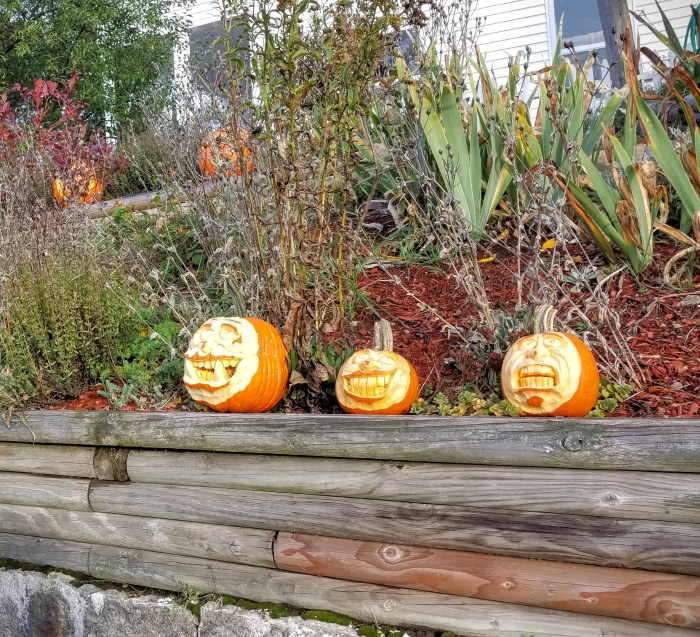Beauport Hotel guests can explore the city of Gloucester, MA, and Cape Ann…by bike. What a great perk for visitors!
Biking culture linked with tourism in Gloucester and Cape Ann hearkens way back…as in 1878. Scroll down to see historic tourist guides from 1881 and 1885 that catered to cyclists and visitors. The sights and recommendations are the ones we continue to celebrate.
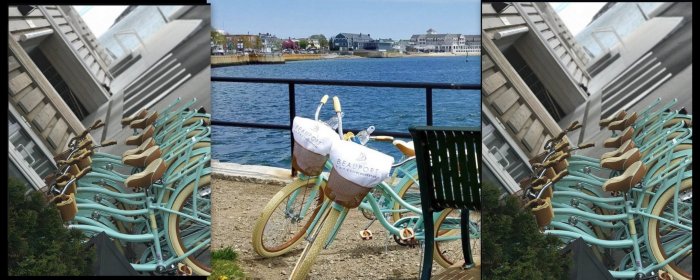
Lookout Hill and Stage Fort Park as seen here from the Beauport Hotel deck is just a close walk or bike ride away.

Enjoy excerpts from an 1885 cyclist tourist guide
In and Around Cape Ann: A Handbook of Gloucester, Mass., and Its Immediate Vicinity. For the Wheelman Tourist and the Summer Visitor by John S. Webber, Jr with eleven illustrations. Gloucester, Mass: Printed at the Cape Ann Advertiser Office, 1885. Library of Congress collection
“…After months of labor–hard labor, too, for one unaccustomed to the work–I am permitted to send forth the present little manual on Gloucester and its immediate vicinity. The material here given is designed for the especial use of the touring wheelman and the summer visitor, and I have endeavored to describe–in a way perhaps peculiar–all the most important sights and places of interest to be found upon this rock-bound territory of Cape Ann…
“The streets about town are generally in condition for bicycle riding, though the surface of most of them is either cut up by thick patches of the coarsest gravel or a layer of loosely lying stones; the rider, however, can pick his way along without any very serious trouble. Main street is paved with square blocks of granite from Porter street to Hancock street, and from Chestnut street to Union Hill. Western avenue, or more frequently spoken of as the “Cut,” is a favorite street for bicycle riding; beyond the bridge take the deserted sidewalk on the left, and enjoy a very pleasant spin upon its easy running surface…
the first suggested itinerary- Bicycle rambles on Eastern Point
“And now let’s take our wheel for a short run along our harbor road to East Gloucester, and note the many points of interest on the way. The start is made at the Gloucester Hotel–the headquarters of all visiting wheelmen in the city–at the corner of Main and Washington streets;
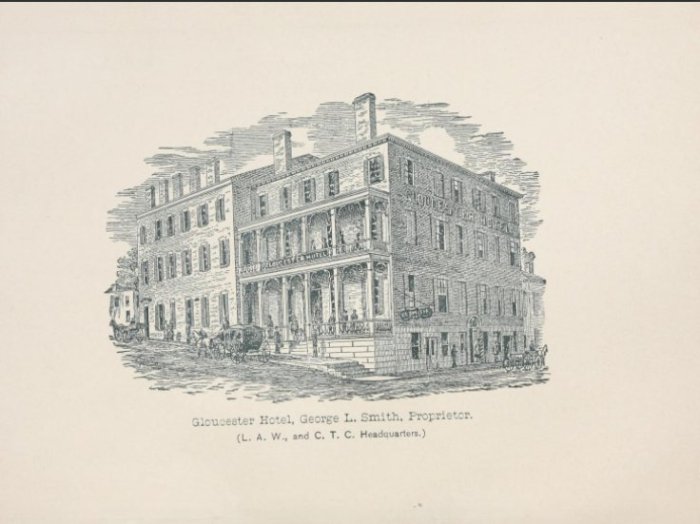
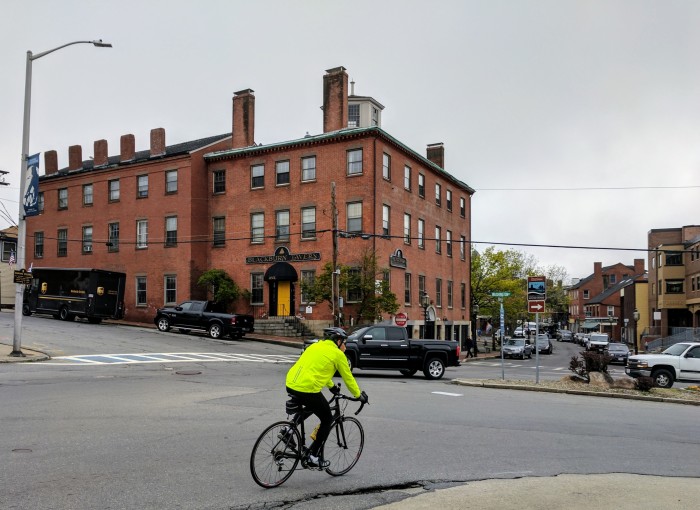
photo: cyclist on the bend passing brick building at Main and Washington now features Tonno Restaurant. Notice the chimneys and same stairs as when it was the Gloucester Hotel. “Special Rates Made to Wheelmen”

“from thence the journey takes us over the rather uneven surface of Main street, going directly toward the east. In a few minutes we pass the Post Office on the left, and soon leave the noisy business portion of the street behind us, then, e’re we are aware of it, we reach and quickly climb the slight eminence known as Union Hill. Once over the hill the road has a downward grade, with generally a very muddy surface, but on through this we propel our machine to the curve in the road at its junction with Eastern avenue. To the right we follow the now well trodden thoroughfare and again pedal quickly up the steep incline before us. Now the machine is well taken in hand, and with a sharp look-out ahead a pleasant little coast over the gently sloping road is cautiously indulged in; down, down we spin, following the main road to the right over the well worn surface, an on, on we glide, past the dwellings of the rich and poor, directly though the business section of the settlement, until in a few minutes we reach the “Square,” so called, at the village center. Passing the pump at this place on our left, we continue the ride over the mud-covered highway, enjoying highly the magnificent stretch of harbor scenery before us. A short distance, and the first dismount is now taken at the foot of a rough incline known as “Patch’s Hill.” At this place are a number of prominent Summer cottages, among them being the Delphine House, Craig Cottage and Brazier Cottage, each affording first-class accommodations, with facilities for bathing, fishing, and boating in close proximity. Once again we bestride the slender wheel and continue on for half a dozen rods or more to the gate-way at the entrance to Niles’ Beach, which marks the terminus of the public way…
Celebrity spotting famous authors
“…Our trip on the bicycle in this direction has finished, and so we sit awhile on the near-at-hand rocky bluff and watch the merry throng of bathers in their sportive antics in the cooling sea, and inwardly wish that we were among them in the refreshing exercise. At our back, as we sit facing the sandy shore, is the little Summer abode of the well known authoress, Elizabeth Stuart Phelps–the cottage in which she has already penned a great number of interesting works, and where she passes the greater portion of the long, warm Summer days.
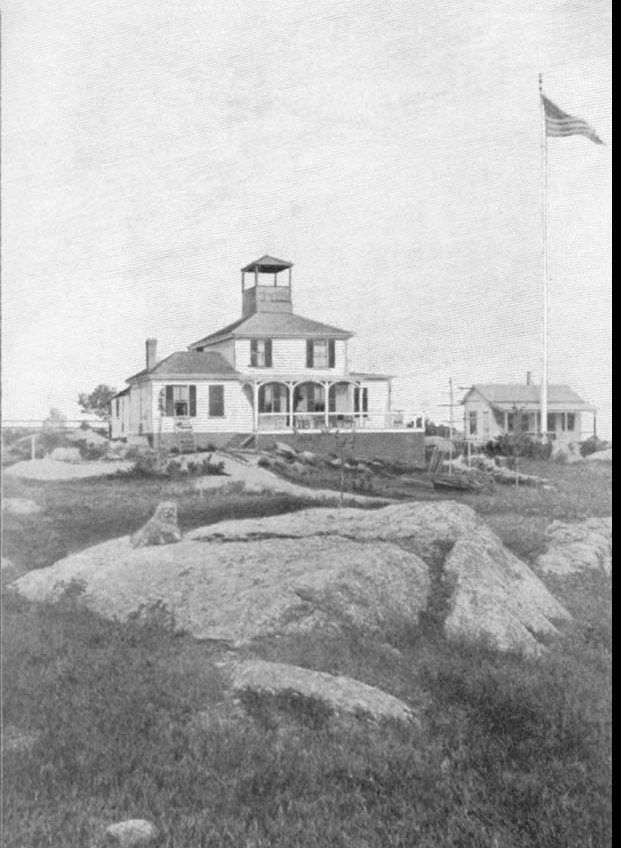
photo caption: Elizabeth Stuart Phelps house
“Directly in front of us, at the further end of the beach, is the old mansion house of the Niles family, and still further on, at the extreme end of the rocky shore, is the tall stone column of Eastern Point Light. “The walk across the beach and over the narrow winding tree bordered path is well worth taking, and makes a pleasant



